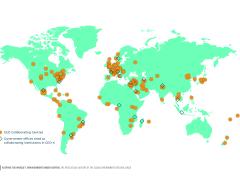DNB and PBL: biodiversity loss is a source of financial risk
The financial sector is exposed to risks as a result of biodiversity loss. This emerged from a joint study by Dutch Central Bank (DNB) and PBL Netherlands Environmental Assessment Agency. The new study builds on the report Values at risk?, published last year by DNB, in which risks of biodiversity loss were investigated in qualitative terms.
Dependence of the financial sector on biodiversity
Biodiversity is the diversity within species, between species and between ecosystems. Biodiversity loss is a source of financial risks and threatens the availability of ecosystem services, such as wood, animal pollination and soil fertility, on which economic activities depend. As a result, banks, pension funds and insurers that finance these economic activities face physical risks.
Dutch financial institutions worldwide have EUR 510 billion in exposure to companies with high or very high dependency on one or more ecosystem services. This comprises 36% of the portfolio examined. One of these ecosystem services is animal pollination. At a global level, the financial sector's exposure to products that depend on pollination amounts to EUR 28 billion.
Impact of the financial sector on biodiversity
Financial institutions run reputation and transition risks when they finance companies that have a major negative impact on biodiversity. For example, Dutch financial institutions worldwide have contributed EUR 97 billion in finance to companies involved in environmental controversies. Negative impact that can be traced back to a specific company results in reputational damage for the company itself as well as for the financial institutions funding it.
Companies must adapt their operations to government policy and changing consumer preferences aimed at reducing the damage to biodiversity. The transition to less nitrogen-intensive business models can expose the EUR 81 billion in loans that the three large Dutch banks have made to Dutch sectors with nitrogen-emitting activities to transition risks.
Biodiversity risks: an important caveat
Financial institutions must ensure they identify the exposure of their portfolios to biodiversity risks in a timely manner, since in-depth understanding of these risks informs adequate risk management. The joint DNB-PBL study has identified only the lower limit of the total exposure of financial institutions to risks of biodiversity loss. Due to the limited availability of data, we were able to investigate only a limited number of biodiversity risks. Based on the results, therefore, it cannot be concluded that other risks are less relevant. It is important to further develop consistent and widely applied standards for measuring and disclosing biodiversity risks.
Climate and biodiversity
Climate change is one of the main causes of biodiversity loss. The reverse is also true – loss of biodiversity, for example through deforestation and resulting carbon emissions, can accelerate climate change. This means proper forest management can help prevent further climate change. In addition, historical data are not representative for predicting future developments with respect to either climate change or biodiversity loss.
It is therefore important that financial institutions take a coherent approach to climate-related risks and biodiversity risks in their risk management.
Coronavirus (COVID-19) and biodiversity
We acknowledge that financial institutions are facing major challenges as a result of the COVID-19 pandemic. Our immediate attention focuses on the consequences of the pandemic for financial institutions. At the same time, it remains essential to continue to focus on longer-term risks, such as biodiversity loss.
The joint DNB-PBL study must be seen in that light. We did not study the relationship between the coronavirus and biodiversity owing to a lack of knowledge.




